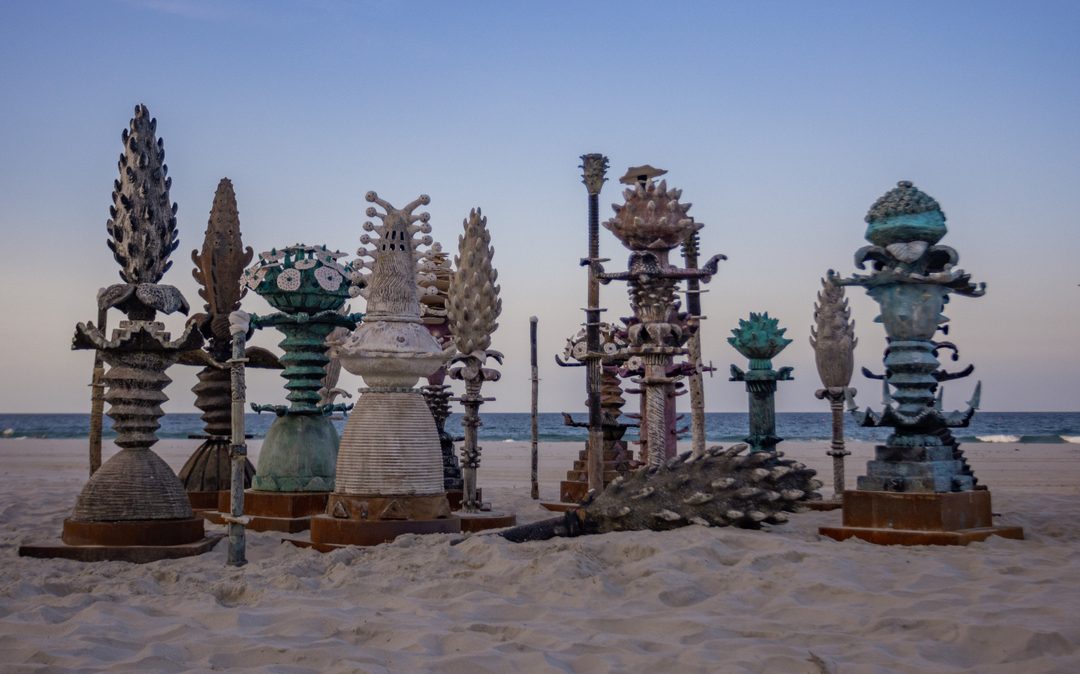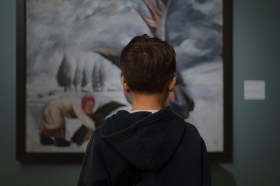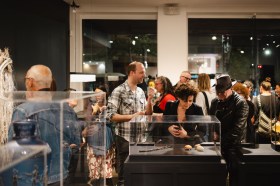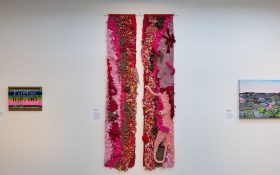Accessibility to art is invaluable because it provides a person with a disability the opportunity to access unlikely spaces and to gain a more meaningful insight into relevant arts practices.
The iconic SWELL Sculpture Festival has graced the shore of Currumbin Beach since 2003. Two decades later, yet another cohort of 75 visionary artists were awarded the honour of exhibiting their eclectic artworks along the beautiful shoreline. By exposing the sculptures to the natural elements, SWELL is a test of resilience and testament to the artists’ unrestricted approach to their individual creative disciplines.
My disability is such that I have to use a manual wheelchair to mobilise. My intention to visit this year’s annual festival was indeed twofold. First, I’ve long wanted to experience first-hand how accessible the SWELL Sculpture Festival really is. Second, I wanted to gain a better understanding of the processes involved in creating these captivating artworks and their combined social commentaries. The opportunity to join an accessible guided tour was the ideal way for me to experience both of the aforementioned.
The Festival was far busier than I expected, but we managed to find a designated disabled parking bay. These are scattered along the main strip like precious jewels due to the fact that they do allow for easier access to the footpath bordering the shoreline without having to navigate your way across the busy main street. A short push along the uneven cement walkway led to the information booth, our meeting point.
The tour began promptly. Our tour guide was well-equipped with a microphone that was plugged into a portable speaker – much needed accessories to be able to speak over the din of the multitude of visitors.
The annual SWELL Sculpture Festival is located along the main strip of Currumbin Beach. Sculptures were installed on the grassy area beside the concrete walkway as well as on the beach, and even an elevated rock outcrop was innovatively utilised as an installation point. Due to the terrain – sand, grass, uneven concrete footpath, limited beach matting – visitors with a disability may well find it challenging to view the sculptures up close. In this instance, having a guide to explain the concept behind the sculptures was extremely helpful.
Read: Twenty-year strong sculpture festival builds connections for intergenerational audiences
Being able to witness first-hand these magnificent sculptures in this natural setting was indeed food for the soul. The array of materials used during the creative process was impressive. According to our guide, this list included elements like steel, stone, aluminium, wire, fabric, tiles, ceramics, plastic, neon paint and even Holden/Ford/Valiant car body parts. Upcycled and recycled components were also a strong feature across the 75 sculptures. These materials were blended and used creatively across the installations, resulting in some eye-catching and intricately designed works.
The hardy materials and components that the artists chose were in stark contrast to the natural surroundings of ocean, sand and native flora, lending another feature to their durability and reinforcing the concept of living in harmony with nature. Special mention can be given to Blue Butterfly Effect by Lyn Haddon. A pandanus tree near the concrete walkway was adorned with hundreds of metallic butterflies. A Bluetooth device was fitted to sense the presence of passersby, which triggered the butterflies to light up and flutter their wings. This was just one example of the many innovative and visionary artistic approaches on offer at SWELL.
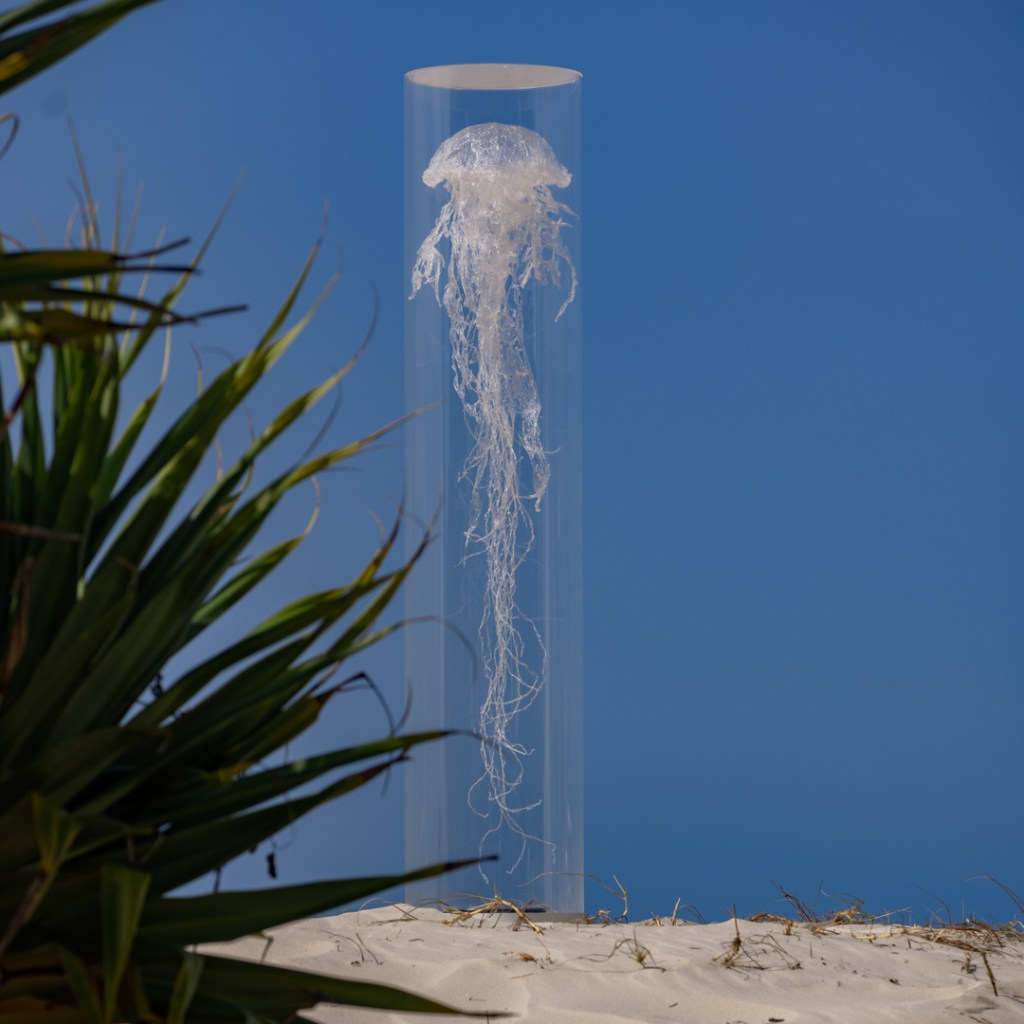
Along the main walkway, a short path made of steel netting encased in wood led onto the beach. I welcomed this accessible lookout point as I was able to get close enough to admire the sculpture designed by New Caledonia artist Sophie Gilbert. Her work Méduse is made of plastic and acrylic. A jellyfish made of anthropogenic (marine debris) plastic is captured inside an acrylic tube, a nod to the destruction and contamination of our oceans through pollution. But in spite of destructive human activities that harm the environment, Méduse also signifies hope, represented by the survival of the jellyfish.
As we continued our tour, this writer noticed a group of disabled visitors using a variety of mobility devices resting in a nearby shaded area. There were several people using wheelie walkers and canes to assist them to mobilise, albeit slowly, stopping occasionally to admire the sculptures. A visually-impaired visitor, white cane in hand, braved the crowd as they made their way cautiously along the outer perimeter of the cement walkway.
There is only one other accessible point of entry for a wheelchair user that allowed for easy access onto the beach. The specially installed sturdy beach matting gave me the opportunity to view Eleri Jones’ installation, Finity – winner of the Neumann Family SWELL Sculpture Award – up close as it nestled in the sand. Finity comprised a waterproof bag containing one tonne of sifted beach sand. The bag is suspended in mid-air from a rusty crane. The sand trickles through a tiny hole in the bag alluding to the passing of time, like a sand timer. For the duration of the Festival, gravity will slowly release the sand and return it to the beach, its origin.
Our tour was most informative and I was satisfied with the wealth of information so enthusiastically shared by our delightful and well-versed tour guide. Being able to engage in conversation with our guide as well as tour participants was extremely useful in gaining different perspectives on the sculptures. All in all, I was beyond pleased to be able to view nearly 40 works up close in my wheelchair!
Read: Radical access: the future of access in the arts
I left feeling exhilarated, all due to the impressive collection of sculptures, the close proximity to the calming ocean and the refreshing sea breeze. The SWELL Sculpture Festival is indeed unique and Currumbin is the perfect outdoor gallery for magnificent interactive sculptural works.
21st SWELL Sculpture Festival runs from 8-17 September along Gold Coast’s Currumbin Beach, Queensland.
This article is published under the Amplify Collective, an initiative supported by The Walkley Foundation and made possible through funding from the Meta Australian News Fund.
